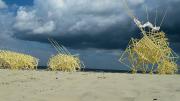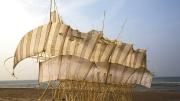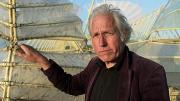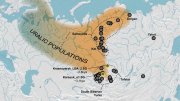PVC tubing and zip ties form the essential “bones” of Dutch artist Theo Jansen’s otherworldy yet mobile strandbeests (“beach animals”), eight of which are on display at the Peabody Essex Museum (PEM) starting September 19. Included is his latest and never-before-seen Animaris Umerus Segundus, along with sketches that offer insight into Jansen’s creative process during the last 25 years; “fossils” of creatures no longer “alive”; and video of some “beests” traveling in gangly equine elegance along a sandy seacoast in The Netherlands. Also on view are original photographs by Lena Herzog (published last year in Strandbeest: The Dream Machines of Theo Jansen) who spent seven years documenting the origins and inner workings of this new kinetic species. This marks the first major American show of Jansen’s large-scale works; it moves on to the Chicago Cultural Center and San Francisco’s Exploratorium. Jansen himself will visit the Greater Boston area for a few events, such as a panel discussion (to be webcast) with Trevor Smith, PEM’s curator of the present tense, and MIT associate professor of media arts and sciences Neri Oxman, taking place on September 10 (3-5 p.m.) at the MIT Media Lab—followed by a live, outdoor demonstration of a walking strandbeest (5:30-7 p.m.).
Theo Jansen's "strandbeests" visit the Peabody Essex Museum
Theo Jansen's "strandbeests" visit the Peabody Essex Museum
Dutch artist Theo Jansen's otherworldly strandbeests

Animaris Adulari (2012)
Photographs courtesy of Theo Jansen

Animaris Apodiacula (2013)
Photographs courtesy of Theo Jansen

Dutch artist Theo Jansen melds art and engineering in his intricate skeletal sculptures.
Photograph by Loek van der Klis
You might also like
Creepy Crawlies and Sticky Murder Weapons at Harvard
In the shadows of Singapore’s forests, an ancient predator lies in wait—the velvet worm.
Concerts and Carols at the Isabella Stewart Gardner Museum
Tuning into one of Boston's best chamber music halls
Japan As It Never Will Be Again
Harvard’s Stillman collection showcases glimpses of the Meiji era.
Most popular
Explore More From Current Issue

An International Student on Staying Silent in Trump’s America
What is the price of a Harvard education?

Parks and Rec Comedy Writer Aisha Muharrar Gets Serious about Grief
With Loved One, the Harvard grad and Lampoon veteran makes her debut as a novelist.

The Origins of Europe’s Most Mysterious Languages
A small group of Siberian hunter-gatherers changed the way millions of Europeans speak today.





